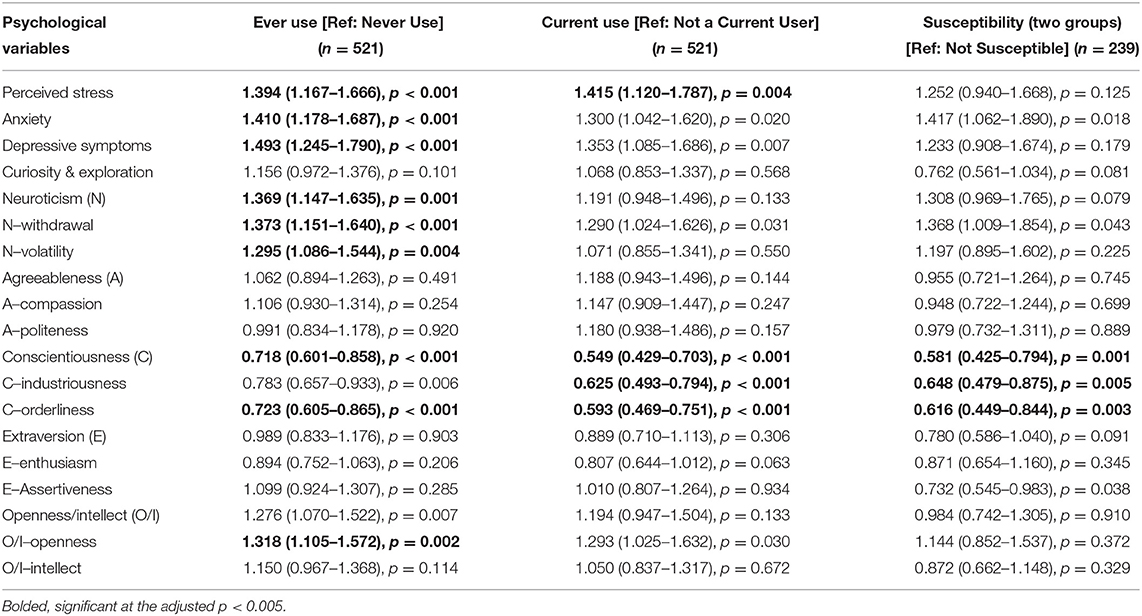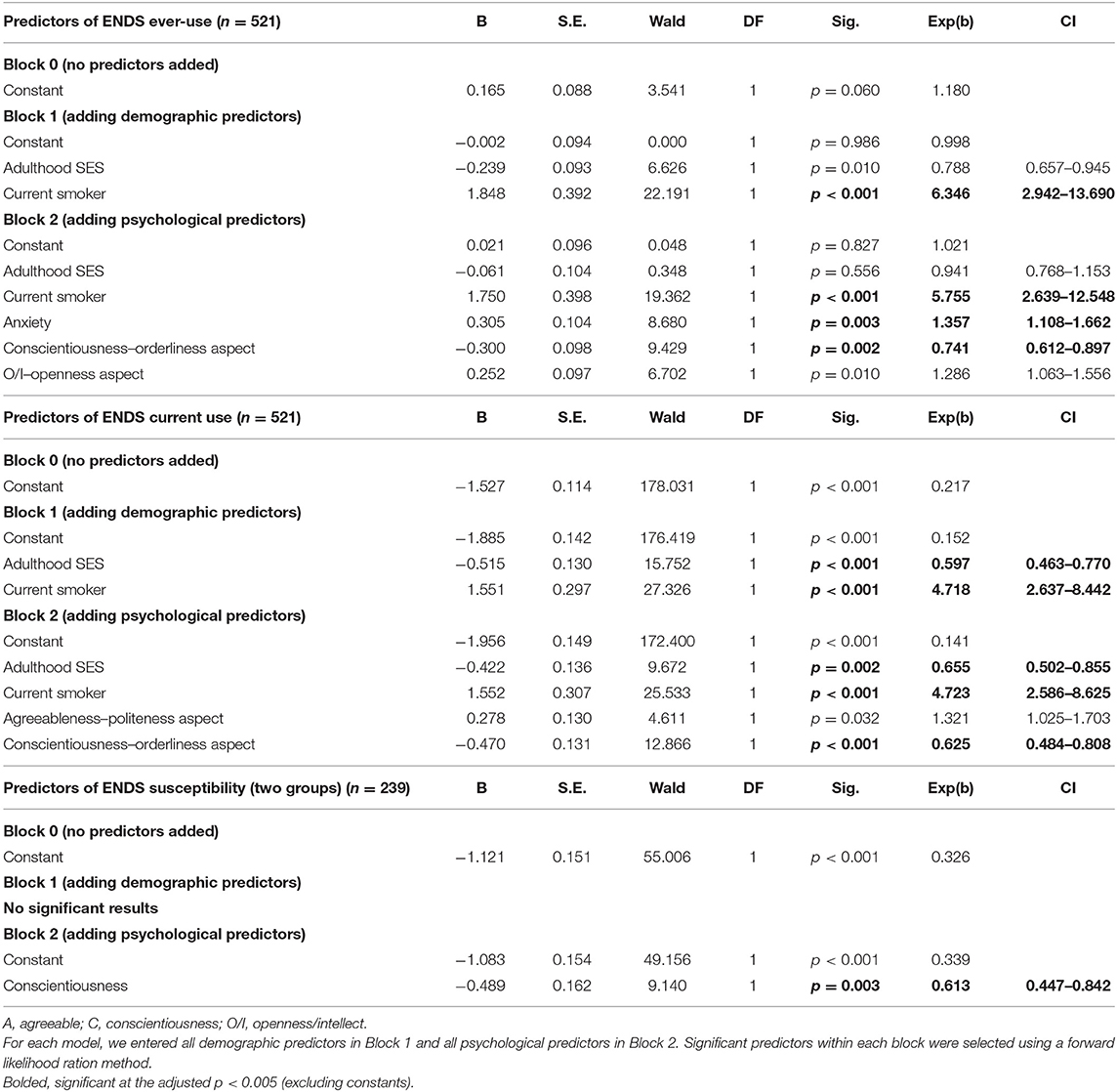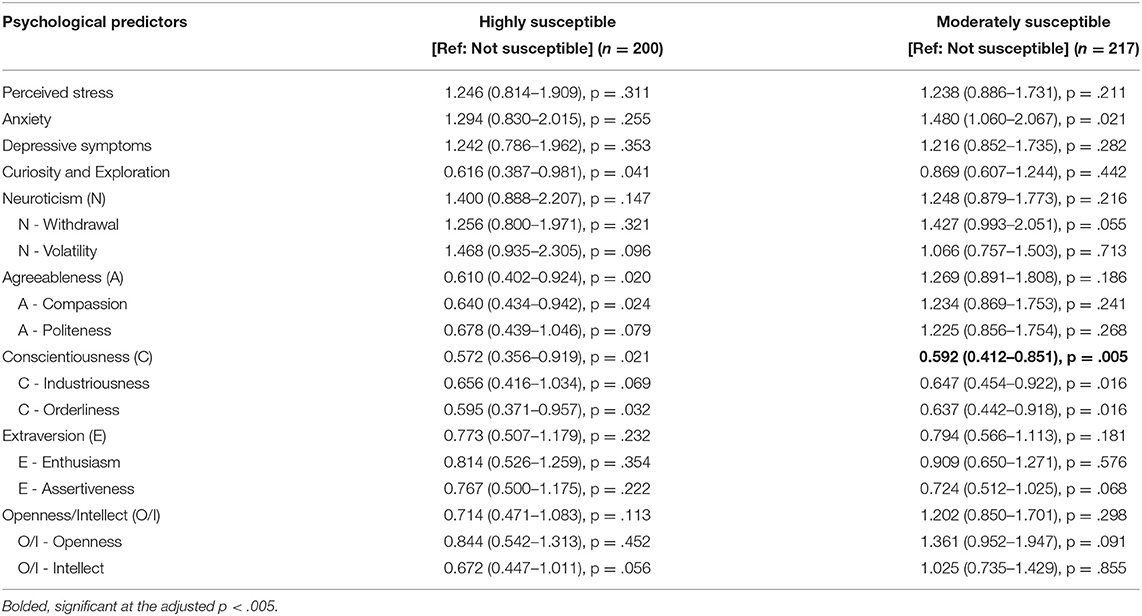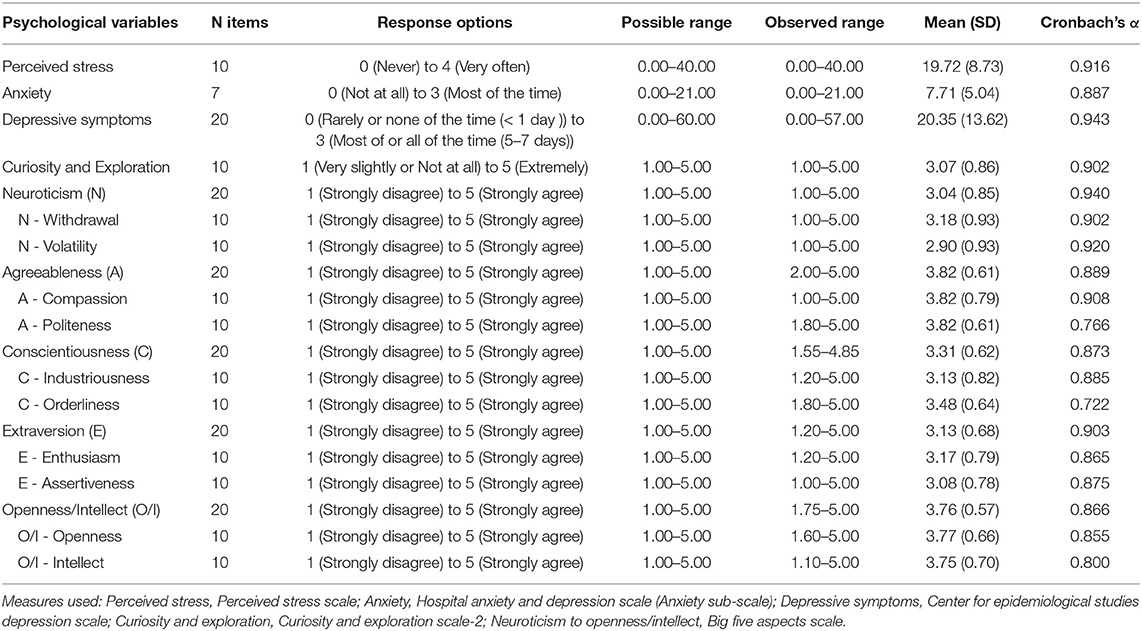Psychological and Demographic Predictors of Vaping and Vaping Susceptibility in Young Adults
A Corrigendum on
Psychological and Demographic Predictors of Vaping and Vaping Susceptibility in Young Adults
by Teah, G. E., and Conner, T. S. (2021). Front. Psychol. 12:659206. doi: 10.3389/fpsyg.2021.659206
In the original article, there was an error in Table 3 and Table 4 as published. The statistics for the Openness and Intellect aspects were reversed due to a coding error. The corrected Table 3 and Table 4 appear below. Amendments have also been made to Supplementary Table 1 and Supplementary Table 4.

Table 3. Results of independent logistic regressions showing estimates in odds ratios (confidence intervals) for psychological predictors of ENDS ever-use, current use, and susceptibility.

Table 4. Results of the multiple logistic regression showing estimates in odds ratios (confidence intervals) for ENDS ever-use, current use, and susceptibility based on the two groups categorization.

Supplementary Table 4. Results of independent logistic regressions showing estimates in odds ratios (Confidence intervals) for psychological predictors of ends susceptibility based on the three groups categorization.
Due to this coding error, there was also an error in Results, Independent Logistic Regression, Paragraph 2. The Openness and Intellect aspects were reversed. The corrected paragraph is below.
Table 3 presents the independent logistic regressions for the psychological predictors. Here, we found nine significant predictors of ever-use, four significant predictors of current use, and three significant predictors of susceptibility at our adjusted threshold of p < 0.005. Ever-users had a more distressed psychological profile than current users or ENDS susceptible people. Scoring one standard deviation above the mean in Perceived Stress, Anxiety, or Depressive Symptoms increased the likelihood of ENDS ever-use by 39.4, 41.0, and 49.3%, respectively. Similarly, the one personality trait linked closely with mental health problems, Neuroticism, also increased the likelihood of ENDS ever-use by 36.9% through both of its aspects. Fewer of the mental health variables predicted ENDS current use or susceptibility aside from Perceived Stress increasing the likelihood of current use by 41.5%. Conscientiousness was a significant personality predictor of all three outcomes; higher Conscientiousness decreased the likelihood of ever-use by 28.2%, current use by 45.1%, and susceptibility by 41.9% through one or both aspects. Additionally, our analyses of susceptibility using three-group categorization found that higher Conscientiousness decreased the likelihood of moderate susceptibility by 40.8% [OR(CI) = 0.592 (0.412–0.851), p = 0.005] (Supplementary Table 4). Contrary to predictions, Curiosity and Exploration did not predict any of the ENDS measures. Only the Openness aspect of Openness/Intellect predicted increased likelihood of ever-use by 31.8%.
Due to this coding error, there was also an error in Discussion, Paragraph 1. The Openness and Intellect aspects were reversed. The corrected paragraph is below.
This study explored the demographic and psychological predictors of ENDS use and susceptibility in 521 young-adult MTurk workers in the United States. Overall, we found more predictors of ENDS ever-use and current use than susceptibility. Ever-users and current users were both demographically and psychologically vulnerable. Demographically, ever-users and current users were more likely to be current smokers, of poor socioeconomic means, and current users were also less likely to have pursued any higher education above the high school level. Psychologically, ever-users were more distressed, higher in neuroticism, less conscientious, and higher in openness, whereas current-users were more stressed and less conscientious. Multiple logistic regression showed the importance of current smoking, anxiety, and conscientiousness predicting ENDS ever use, and current smoking, adulthood SES, and conscientiousness predicting ENDS current use. The only predictor of ENDS susceptibility was lower conscientiousness. This paints an interesting picture of the factors that predict ENDS use and susceptibility, as compared to the known predictors of smoking below.
Due to this coding error, there was also an error in Discussion, Paragraph 6. The Openness and Intellect aspects were reversed. In addition Discussion, Paragraph 6 did not address two pieces of literature: Zvolensky et al. (2015) and Leung et al. (2013). The corrected paragraph is below.
Our exploratory analysis of the personality predictors of ENDS yielded interesting results. The most consistent finding was that ENDS ever-users, current users, and susceptible people shared one personality characteristic: lower conscientiousness. This maps closely to findings from smoking research (Malouff et al., 2006; Hakulinen et al., 2015), and to the wider literature on higher conscientiousness being linked to positive health behaviors (Bogg and Roberts, 2004). Like smoking, neuroticism also predicted likelihood of ENDS ever-use; however, it appeared that anxiety, not neuroticism, was the more important predictor of ENDS ever-use from the multiple logistic regressions. Furthermore, unlike smoking, we found no evidence for higher extraversion among ENDS users. However, ENDS ever-users were higher in the openness aspect, which suggests that young adults with high levels of openness are more likely to have used ENDS at least once in their lives. These findings are reflected in previous smoking literature, showing that higher openness to experience increases the likelihood of smoking (Zvolensky et al., 2015), as well as lower openness to experience being a predictor of quitting smoking (Leung et al., 2013). Further work is necessary to replicate associations between openness and ENDS use and susceptibility.
The authors apologize for these errors and state that they do not change the primary scientific conclusions of the article. The original article has been updated.
Publisher's Note
All claims expressed in this article are solely those of the authors and do not necessarily represent those of their affiliated organizations, or those of the publisher, the editors and the reviewers. Any product that may be evaluated in this article, or claim that may be made by its manufacturer, is not guaranteed or endorsed by the publisher.
References
Bogg, T., and Roberts, B. W. (2004). Conscientiousness and health-related behaviors: a meta-analysis of the leading behavioural contributors to mortality. Psychol. Bull. 130, 887–919. doi: 10.1037/0033-2909.130.6.886
Hakulinen, C., Hintsanen, M., Munaf,ò, M. R., Virtanen, M., Kivimäki, M., Batty, G. D., et al. (2015). Personality and smoking: individual-participant meta-analysis of nine cohort studies. Addiction 11, 1844–1852. doi: 10.1111/add.130
Leung, D. Y., Au, D. W., Lam, T. H., and Chan, S. S. (2013). Predictors of long-term abstinence among Chinese smokers following treatment: the role of personality traits. Asian Pac. J. Cancer Prev. 14, 5351–5354. doi: 10.7314/apjcp.2013.14.9.5351
Malouff, J. M., Thorsteinsson, E. B., and Schutte, N. S. (2006). The five-factor model of personality and smoking: a meta-analysis. J. Drug Educat. 36, 47–58. doi: 10.2190/9ep8-17p8-ekg7-66ad
Keywords: e-cigarette, electronic cigarette, vaping, survey, personality, mental health, young adult, socioeconomic status
Citation: Teah GE and Conner TS (2022) Corrigendum: Psychological and Demographic Predictors of Vaping and Vaping Susceptibility in Young Adults. Front. Psychol. 13:871241. doi: 10.3389/fpsyg.2022.871241
Received: 07 February 2022; Accepted: 25 February 2022;
Published: 22 April 2022.
Edited and reviewed by:
Changiz Mohiyeddini, Oakland University William Beaumont School of Medicine, United StatesCopyright © 2022 Teah and Conner. This is an open-access article distributed under the terms of the Creative Commons Attribution License (CC BY). The use, distribution or reproduction in other forums is permitted, provided the original author(s) and the copyright owner(s) are credited and that the original publication in this journal is cited, in accordance with accepted academic practice. No use, distribution or reproduction is permitted which does not comply with these terms.
*Correspondence: Tamlin S. Conner, tamlin.conner@otago.ac.nz
 Grace E. Teah
Grace E. Teah Tamlin S. Conner
Tamlin S. Conner